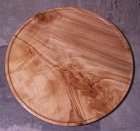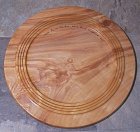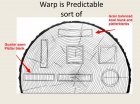I have these maple rounds that are 25"diameter that I got in the spring( I posted here to Identify what it was I had), I'm finally getting around to doing something with them.
I cut one of them in half parallel with the grain then cut two slabs 3"thick from one of the halves. My intention is to turn nesting platters with these slabs.
Question is can I turn these while green and turn twice like I would do a bowl or would it be more advised to wait and dry them then turn once. Reason I ask is because I don't want warpage in these particular pieces since they are nesting. Also with such large diameter I would imagine the warpage would be exaggerated, is that correct?
If I could turn them twice, once green and once when the warping has completed what rough thickness would you think I should make them or at least the largest of them. I'm thinking the largest finished diameter is going to be around 16" and sit around 1,1/2" base to rim.
I cut one of them in half parallel with the grain then cut two slabs 3"thick from one of the halves. My intention is to turn nesting platters with these slabs.
Question is can I turn these while green and turn twice like I would do a bowl or would it be more advised to wait and dry them then turn once. Reason I ask is because I don't want warpage in these particular pieces since they are nesting. Also with such large diameter I would imagine the warpage would be exaggerated, is that correct?
If I could turn them twice, once green and once when the warping has completed what rough thickness would you think I should make them or at least the largest of them. I'm thinking the largest finished diameter is going to be around 16" and sit around 1,1/2" base to rim.




